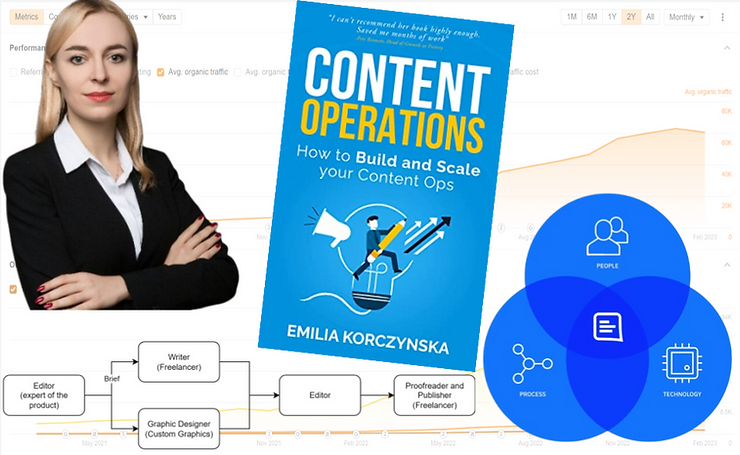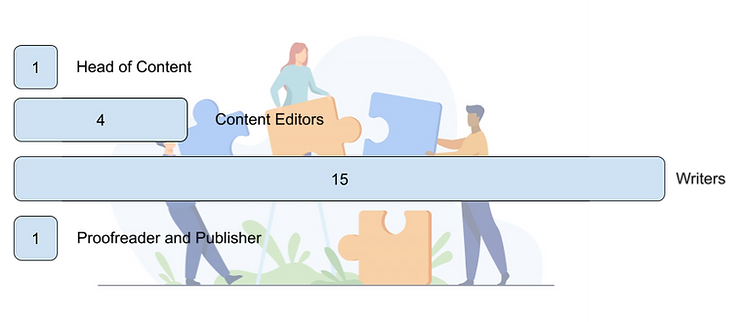

Discover more from Harmony
How to Multiply Your Organic Traffic by following Emilia’s Content Operations playbook
How to create 100+ relevant blogs each month? Emilia Korczynska, Author of Content Operations, explains the process and people required.
In her position as Head of Marketing at Userpilot, Emilia Korczynska has led one of the most amazing transformations, moving from a few blogs a month to over 100+ blogs published each month. I was fortunate to have the opportunity to interview Emilia to gather more insight about how Userpilot achieved this feat, as well as some tips she has for others who operate in the B2B SaaS space.
I reached out to Emilia to learn how to build a freelance content writing team for a consulting client at Spark Creative Technologies. I was blown away by Emilia's insights during our chat and in her book Content Operations. There are 1,000s of companies looking for these answers. If this catches your interest, let's get into it!
Thumbnail includes an illustration from Gather Content.
This article covers my takeaways from our chat. You can hear the insights straight from Emilia on YouTube here:
This article was originally posted at www.harshal-patil.com on 13th Feb 2023.
Creating Clear Content Processes to Ensure Userpilot’s Success
Organizational transformations are inevitable when it comes to the desire to expand to increase the firm’s volume of content. Emilia shared that Userpilot adjusted how they managed their content writers and people by creating transparent, streamlined processes.
In the past, Userpilot worked with in-house content writers. But, writers creating content exclusively for the same product every day felt a lack of career progression. Emilia observed attrition amongst the writers due to this repetitive nature of work.
Emilia and her team focused on the following:
Working Exclusively With Independent Contractors: Emilia sought out writers on LinkedIn and Medium who were specialists in niches related to Userpilot’s existing and future content goals. This approach helped them eliminate attrition.
Creating a New Process with Clear Steps: Emilia and her head of content made a process for content publication. Each person had a specific role - writers, editors, or other experts - so there was no confusion and more ownership over each process step.
Today, Userpilot’s content team is quite different than it used to be. The group comprises one head of content and four in-house full-time content editors. Ten to fifteen writers produce one blog per week, but some complete up to three blogs per week. Userpilot employs one proofreader to oversee the content in its final stages, ensuring it is polished before publication.
Background graphics: Image by pch.vector on Freepik
Finding the Right Freelancers for Userpilot’s Niche
Userpilot sought independent contractors through two channels:
LinkedIn and
Medium.
LinkedIn was the best place for specialists in Userpilot’s niche rather than hiring from marketplaces where individuals completed work in diverse subjects. When sourcing individuals who published on Linkedin or Medium, Emilia and her team could identify writers with the needed expertise. However, there are a lot of writers out there. What was the process for hiring?
Userpilot created an application process to identify the best writers. Individuals had to submit work samples, complete a form, and give an Aptitude test. They tailored the test to the type of content Userpilot would ask them to do in the future. One example was asking writers to write an article on the role of a Product Manager.
The application process began with the same application form, even for all content editors. But there was a different task to test their skills. There is a time-boxed editor aptitude test in the application process to measure an individual’s skills and ability to handle pressure and deadlines. In this test, candidates have a set of tasks testing their research, analytical, writing, organizational, and time-management skills. The tasks involve creating an outline, writing two paragraphs, revere-engineering an Excel formula, and identifying the most relevant features of competitors. You can read more about the Content Editor Aptitude test and marking sheet here.
While these might seem like complex application processes, Emilia said the employees she hired this way have remained with Userpilot long-term! For any company looking to improve its staff retention rates, this technique can help build teams with perfect candidates for any niche.
How to Handle Updating Content and Managing SEO Concerns
For a company like Userpilot, it is not just about writing the content but also about updating it. When I asked Emilia how her team split the time between creation and updating, she gave one piece of advice: wait to update content until the blog has been active for a year.
If you're in the middle of your content journey, updating your blogs is necessary, but if you are starting, give yourself some time to create the required data for your blog to see what needs to be adjusted. Userpilot created about 1,000 pieces of content on their site over 4 years before starting to maintain old blog posts.
Best Tools for Content Production and Management
Emilia and her book mentioned many tools they find helpful, including:
One tool that was a pleasant surprise in the value it delivers was Surfer SEO. Emilia’s team enjoys it because it identifies keywords that rank well and align with the industry and steps to use them in the article. SurferSEO provided a return on investment immediately! Emilia also shared that the team at Userpilot efficiently uses Asana to manage the workflow and create automation.
Advice to Those in B2B SaaS Marketing for the Future
When I asked Emilia what she thought about the future of B2B SaaS marketing, there were a few pieces of advice that she wanted to provide. First, Emilia was sure to explain her concerns about the risk of using AI - yet. As she said, AI is a fantastic tool for research and paraphrasing, but it might not have the full capabilities to allow for great SEO and content performance.
AI-generated content is against Google Guidelines and might result in a penalty. Software tools can tell whether the written content is human-generated or AI-generated. For now, Emilia is focusing her team’s strategy on using AI to help generate ideas for content. Emilia recommends not relying solely on AI for all firms that value their content due to the risk it could pose to one’s brand and webpage ranking.
Emilia’s favorite books she recommends on content production and management include
Product Led SEO and
Content Machine, and of course,
Her book, Content Operations.
On Emilia’s recommendation, I bought and read them. I found them to be good companion pieces. On another note - here are some of Emilia’s favorite thought leaders in the field that you can follow for tips:
Nick Jordan, Founder of Workello
Benji Hyam, Co-Founder of Grow & Convert
Kas Szatylowicz, Head of Organic Growth at V7
Mark Williams-Cook, Director at Candour and Founder of AlsoAsked.com
In her book Content Operations, Emilia details her insights from her journey we heard above.
Upcoming Programmatic SEO Initiative
One of the most exciting developments for Emilia’s team is their future goals for programmatic SEO. Emilia shared that the future involves:
Creating templates.
Discovering formulaic keyword patterns.
Testing different templates to find the best method for content creation.
Emilia believes these templates could produce thousands of blogs that generate the same success and reach as their existing content—if not more! Her team has published around 100 blogs from programmatic efforts, driving conversions at a 5x higher conversion rate than their traditional posts. I am excited to see how their new focus on programmatic SEO will lead to further success. It will be a possible model for other brands to use in the future.
You can find Emilia’s programmatic SEO process and templates here.
The Writing Process for Content Operations
Toward the end of our conversation, I wanted to learn more about the writing process for Content Operations. Emilia shared that while the book is fairly short, creating it was much longer than she anticipated. Writing the initial draft took a few weeks, but editing the text to capture what she aimed for required several rounds of reviews, edits, and proofreading.
Emilia’s interactive, long process was well worth it as her audience received content operations well. The positive reception and her latest experiments have inspired her to add more to the book and release an update in the future (Kindle gets auto-updated).
Follow Emilia to Learn More About Content Operations
I had a great time discussing Content Operations at Userpilot with Emilia Korczynska. It was fascinating to learn more about their battle-tested process. If you follow these tips and employ clear strategies and techniques, you, too, can see exponential growth for your company or content strategy.
I hope the information presented in this article gave you insights and inspiration!
For more content like this, you can subscribe here.
To follow Emilia and to keep up with news about the latest release of Content Operations, be sure to follow her on LinkedIn!
This article was originally posted at www.harshal-patil.com on 13th Feb 2023.
Subscribe to Harmony
Harmony of Technology, Business, and Entrepreneurship. Featured on the front page of Hacker News. Trusted resource for 100s of PMs and entrepreneurs. I am building-in-public.














